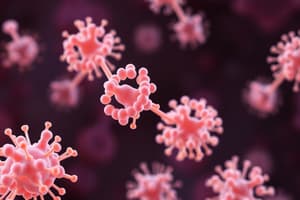Podcast
Questions and Answers
What are the two main components that make up ribosomes?
What are the two main components that make up ribosomes?
Ribosomal RNA (rRNA) and proteins.
Describe the difference in subunit sizes between eukaryotic and prokaryotic ribosomes.
Describe the difference in subunit sizes between eukaryotic and prokaryotic ribosomes.
Eukaryotic ribosomes have a large subunit of 60S and a small subunit of 40S, while prokaryotic ribosomes have a large subunit of 50S and a small subunit of 30S.
Explain the primary functional difference between free and bound ribosomes.
Explain the primary functional difference between free and bound ribosomes.
Free ribosomes synthesize proteins that function within the cytosol, while bound ribosomes synthesize proteins destined for secretion or use in membrane-bound organelles.
At what cellular location are ribosomal subunits assembled in eukaryotic cells?
At what cellular location are ribosomal subunits assembled in eukaryotic cells?
What are the three main stages of the protein synthesis process performed by ribosomes?
What are the three main stages of the protein synthesis process performed by ribosomes?
In what way do mitochondrial and chloroplast ribosomes resemble prokaryotic ribosomes?
In what way do mitochondrial and chloroplast ribosomes resemble prokaryotic ribosomes?
Why are ribosomes considered essential for cell function and growth?
Why are ribosomes considered essential for cell function and growth?
How does the role of ribosomes in protein synthesis reflect the central dogma of molecular biology?
How does the role of ribosomes in protein synthesis reflect the central dogma of molecular biology?
What distinguishes the structure of ribosomes in prokaryotes from those in eukaryotes?
What distinguishes the structure of ribosomes in prokaryotes from those in eukaryotes?
What initiates the process of translation at the ribosome?
What initiates the process of translation at the ribosome?
Study Notes
Ribosomes
-
Definition: Ribosomes are complex macromolecular machines found within all living cells that perform protein synthesis (translation).
-
Structure:
- Composed of ribosomal RNA (rRNA) and proteins.
- Made up of two subunits:
- Large subunit (60S in eukaryotes, 50S in prokaryotes)
- Small subunit (40S in eukaryotes, 30S in prokaryotes)
- Subunits are assembled in the nucleolus (in eukaryotes) and consist of different proteins and rRNA molecules.
-
Types of Ribosomes:
- Free Ribosomes:
- Float freely in the cytoplasm.
- Synthesize proteins that function within the cytosol.
- Bound Ribosomes:
- Attached to the endoplasmic reticulum (rough ER).
- Synthesize proteins destined for secretion or for use in membrane-bound organelles.
- Free Ribosomes:
-
Function:
- Translate messenger RNA (mRNA) into polypeptide chains (proteins).
- The process involves:
- Initiation: Ribosome binds to mRNA and the first tRNA.
- Elongation: Amino acids are added to the growing polypeptide chain.
- Termination: The process ends when a stop codon is reached.
-
Location:
- Found in all living cells (both prokaryotic and eukaryotic).
- In eukaryotic cells, ribosomes can be found in the cytoplasm, on the rough ER, and within mitochondria and chloroplasts.
-
Importance:
- Essential for cell function and growth as proteins are crucial for cellular structure and function.
- Involved in various cellular processes, including metabolism, signaling, and regulation.
-
Ribosomes in Different Organisms:
- Prokaryotic ribosomes are smaller and slightly different in composition compared to eukaryotic ribosomes.
- Mitochondrial and chloroplast ribosomes resemble prokaryotic ribosomes, suggesting an evolutionary link.
Ribosomes Overview
- Ribosomes are crucial for protein synthesis (translation) in all living cells.
- Comprised of ribosomal RNA (rRNA) and proteins, essential for their function.
Structure
- Consist of two subunits:
- Large subunit: 60S in eukaryotes, 50S in prokaryotes.
- Small subunit: 40S in eukaryotes, 30S in prokaryotes.
- Assembly occurs in the nucleolus in eukaryotic cells, involving diverse rRNA and protein components.
Types of Ribosomes
- Free Ribosomes:
- Reside in the cytoplasm, synthesizing proteins that function within the cytosol.
- Bound Ribosomes:
- Attached to rough endoplasmic reticulum (rough ER), producing proteins for secretion or for membrane-bound organelles.
Function
- Ribosomes translate messenger RNA (mRNA) into polypeptide chains (proteins) through three main stages:
- Initiation: Binding of the ribosome to mRNA and the first tRNA.
- Elongation: Sequential addition of amino acids to form a polypeptide chain.
- Termination: Process concludes upon encountering a stop codon.
Location
- Found in all cells, both prokaryotic and eukaryotic.
- Eukaryotic ribosomes can be located in the cytoplasm, attached to rough ER, and within mitochondria and chloroplasts.
Importance
- Essential for cell survival and growth; proteins support cellular structure and function.
- Participate in various cellular processes, including metabolism, signaling, and regulation.
Differences Between Organisms
- Prokaryotic ribosomes are smaller and exhibit differing compositions compared to eukaryotic ribosomes.
- Ribosomes in mitochondria and chloroplasts resemble prokaryotic ribosomes, providing evidence of evolutionary connections.
Studying That Suits You
Use AI to generate personalized quizzes and flashcards to suit your learning preferences.
Description
Explore the intricate world of ribosomes, the essential macromolecular machines responsible for protein synthesis in all living cells. Learn about their complex structure, including the different types of ribosomes and their specific roles in translating messenger RNA into proteins.




